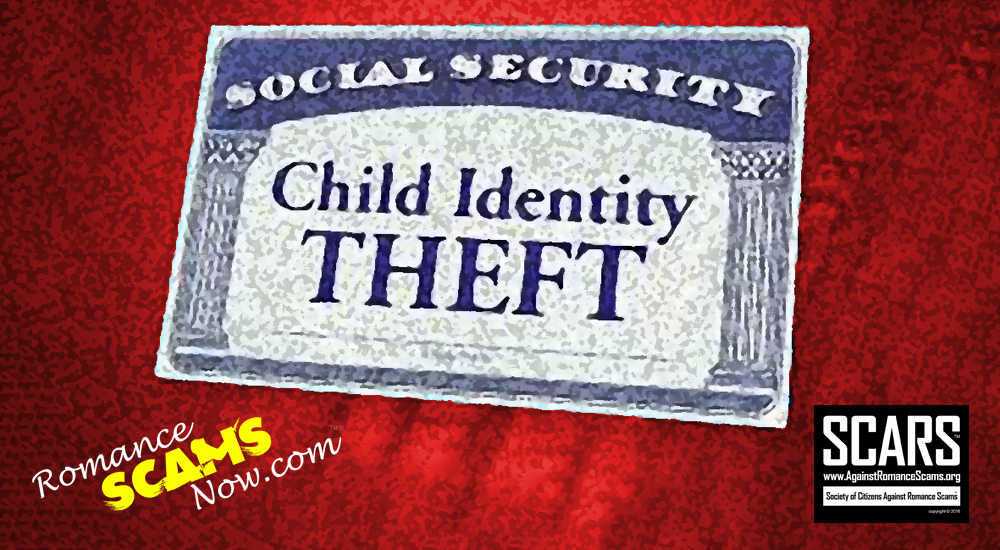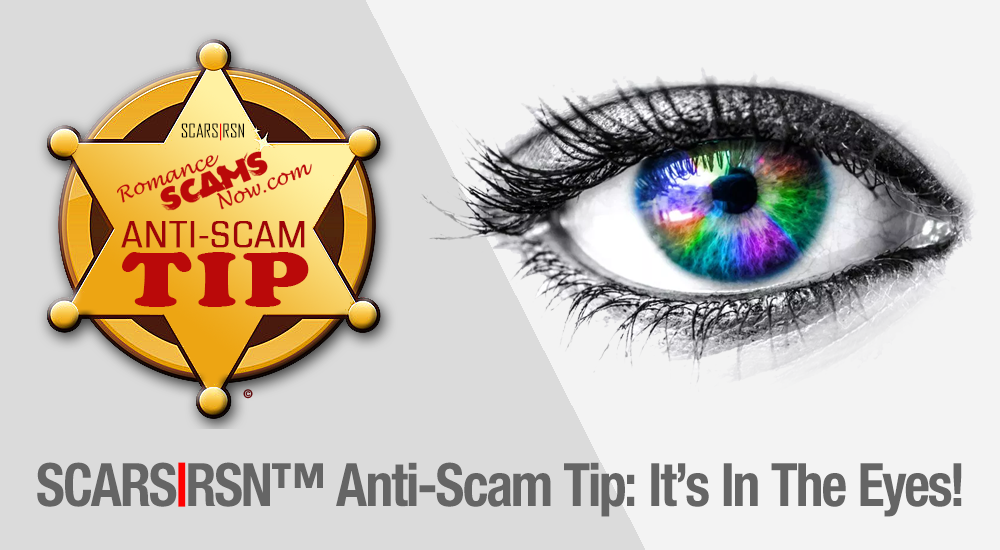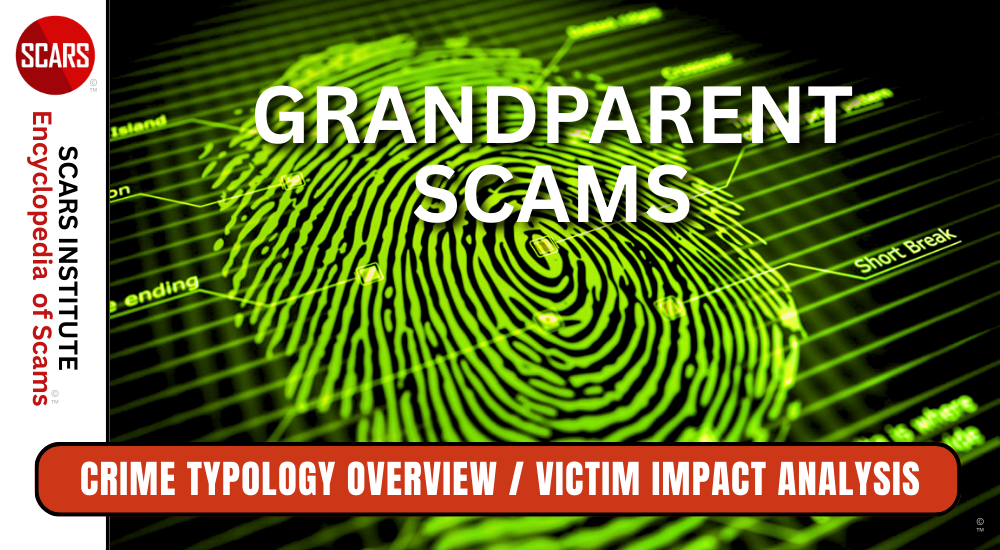SCARS™ Anti-Scam Tip: It’s In The Eyes!
Scammers Don’t Understand
Eye Colors!
Gray, Black, Hazel Are Their Preferred Choice
Silver / Grey Eyes
Silver or Grey (gray) eye color is quite rare, although many consider silver eyes to be a variation of blue eye color. Like blue eyes, silver eyes are the result of a very low amount of pigmentation in the eye, which reflects a gray-silver appearance. Silver eye color is most common in eastern European countries, and is one of the rarest eye colors worldwide. One of the eye colors that is even rarer is Gold.
Black Eyes
There is no such thing as Black Eye Color, though ignorant scammers would not know this. Dark eyes are simply brown in color, with the pupil being black. They can be dark brown, but never black.
Hazel Eyes
Hazel eyes are similar to brown eyes, although they are typically lighter in color, and have more of a green-yellow tint. Hazel eyes have a higher concentration of melanin (pigment) around the eye’s border, which can result in a multi-colored appearance that varies between copper and green depending on the lighting. Most people estimate that around 5-8% of the world’s population has hazel colored eyes. Scammers frequently list Hazel eye color when they can’t see the color in the stolen photo clearly – usually mistaking Blue as Hazel.
Green eye color is often confused with hazel eye color, yet is entirely separate and distinct. Green eye color is the rarest color found around the world, except for true Gold (not to be confused with Amber), and it is estimated that only around 2% of the world’s population has green colored eyes. Green eye color is a result of a mild amount of pigmentation in the eye with a golden tint. When combined with the natural blue scattering of the eye, the colors mix to give a green appearance. Green eye color is most common in northern and central Europe, but can also be found in western Asian cultures on rare occasion. Scammers sometimes mistake Blue for Green and will list Green in the profile, though most of the time they list Hazel.
Blue eyes are genetically recessive, and therefore much less common worldwide. Blue eyes are formed by the absence of pigments in the eye, where the blue color is formed by the scattering of light as it’s reflected off the iris. While blue eyes are less common than brown eyes, they are frequently found from nationalities located near the Baltic sea in northern Europe. It’s estimated that approximately 8% of the world’s population has blue eyes. Scammers frequently will list blue color as hazel, both because the photo that they have stolen is not clear enough, and culturally they think that that color IS hazel. No person who has Blue eyes would ever make that mistake.
Amber Eyes
Amber eyes show off a yellow-copper tone, which results from the yellow colored pigment lipochrome. Amber eyes are very rare worldwide, and are most common in Asia and South American countries. Amber eye color can range from golden yellow to a more copper tone. Gold colored eyes are a variation of Amber but are more yellow, and true gold colored eyes are the most rare of all eye colors.
ANTI-SCAMMER TIP:
Scammers work large numbers of potential victims. It is a game of numbers for them, especially in the early stages of their conversations.
You can usually expose a scammer through the eye color they put on their fake profile!
If they say they have Hazel Eyes, in your messages ask about their “brown” eyes. If they say yes, they have brown eyes, you got them. In other words, just ask about a different color from what the profile says, they generally don’t take the time to check. It is not a perfect test, but the majority of the time, it’s the details that trip them up if you really check!
If you are talking with someone and you want to trip them up just ask for their eye color!
-/ 30 /-
What do you think about this?
Please share your thoughts in a comment below!
Article Rating
Table of Contents
RATE THIS ARTICLE?
LEAVE A COMMENT?
Recent Comments
On Other Articles
- Nikolaus on Dating Scammers Paradise: Ivory Coast: “The Ivory Coast romance scam is still going on. It seems that local authorities don’t handle the issue effectively!” Dec 10, 02:17
- on The SCARS Institute Top 50 Celebrity Impersonation Scams – 2025: “Thank you – we will.” Dec 7, 11:41
- on The SCARS Institute Top 50 Celebrity Impersonation Scams – 2025: “You should add Sean Bean to your list of Celebrities. This one is very good, and persistent. He will be…” Dec 2, 12:07
- on How You Think & Talk About Your Scam Affects Your Recovery: “I have hung on to the scams for far too long. With the intervention of an all-merciful God, I have…” Nov 6, 22:13
- on Disengaging From A Fake Scam Relationship: “Taci, you may want to join our new support community at www.SCARScommunity.org” Nov 6, 03:01
- on Disengaging From A Fake Scam Relationship: “This particular article helped me discover the many things I did wrong the first time I was scammed. I should…” Nov 5, 22:49
- on About the SCARS RomanceScamsNOW.com Website – 24 Years Published: “It was unavailable for a few days, but it is available again. If he would be interested, he is welcome…” Nov 5, 00:59
- on About the SCARS RomanceScamsNOW.com Website – 24 Years Published: “My husband has been scammed and your classes have been helping him but now he can’t seem to access them.…” Oct 26, 14:57
- on Talia Shepard – Impersonation Victim – Stolen Photos – 2024: “Hi, I’m Patrick from Belgium and I found this site by chance, so I just got to know it, and…” Oct 17, 23:46
- on Talia Shepard – Impersonation Victim – Stolen Photos – 2024: “Hallo ik ben Patrick uit Belgie en het is in verband over PayPal. Ik heb het dit jaar spijtig genoeg…” Oct 17, 23:08
ARTICLE META
Important Information for New Scam Victims
- Please visit www.ScamVictimsSupport.org – a SCARS Website for New Scam Victims & Sextortion Victims
- Enroll in FREE SCARS Scam Survivor’s School now at www.SCARSeducation.org
- Please visit www.ScamPsychology.org – to more fully understand the psychological concepts involved in scams and scam victim recovery
If you are looking for local trauma counselors please visit counseling.AgainstScams.org or join SCARS for our counseling/therapy benefit: membership.AgainstScams.org
If you need to speak with someone now, you can dial 988 or find phone numbers for crisis hotlines all around the world here: www.opencounseling.com/suicide-hotlines
A Note About Labeling!
We often use the term ‘scam victim’ in our articles, but this is a convenience to help those searching for information in search engines like Google. It is just a convenience and has no deeper meaning. If you have come through such an experience, YOU are a Survivor! It was not your fault. You are not alone! Axios!
A Question of Trust
At the SCARS Institute, we invite you to do your own research on the topics we speak about and publish, Our team investigates the subject being discussed, especially when it comes to understanding the scam victims-survivors experience. You can do Google searches but in many cases, you will have to wade through scientific papers and studies. However, remember that biases and perspectives matter and influence the outcome. Regardless, we encourage you to explore these topics as thoroughly as you can for your own awareness.
Statement About Victim Blaming
Some of our articles discuss various aspects of victims. This is both about better understanding victims (the science of victimology) and their behaviors and psychology. This helps us to educate victims/survivors about why these crimes happened and to not blame themselves, better develop recovery programs, and to help victims avoid scams in the future. At times this may sound like blaming the victim, but it does not blame scam victims, we are simply explaining the hows and whys of the experience victims have.
These articles, about the Psychology of Scams or Victim Psychology – meaning that all humans have psychological or cognitive characteristics in common that can either be exploited or work against us – help us all to understand the unique challenges victims face before, during, and after scams, fraud, or cybercrimes. These sometimes talk about some of the vulnerabilities the scammers exploit. Victims rarely have control of them or are even aware of them, until something like a scam happens and then they can learn how their mind works and how to overcome these mechanisms.
Articles like these help victims and others understand these processes and how to help prevent them from being exploited again or to help them recover more easily by understanding their post-scam behaviors. Learn more about the Psychology of Scams at www.ScamPsychology.org
Psychology Disclaimer:
All articles about psychology and the human brain on this website are for information & education only
The information provided in this article is intended for educational and self-help purposes only and should not be construed as a substitute for professional therapy or counseling.
While any self-help techniques outlined herein may be beneficial for scam victims seeking to recover from their experience and move towards recovery, it is important to consult with a qualified mental health professional before initiating any course of action. Each individual’s experience and needs are unique, and what works for one person may not be suitable for another.
Additionally, any approach may not be appropriate for individuals with certain pre-existing mental health conditions or trauma histories. It is advisable to seek guidance from a licensed therapist or counselor who can provide personalized support, guidance, and treatment tailored to your specific needs.
If you are experiencing significant distress or emotional difficulties related to a scam or other traumatic event, please consult your doctor or mental health provider for appropriate care and support.
Also read our SCARS Institute Statement about Professional Care for Scam Victims – click here to go to our ScamsNOW.com website.


















Thank you for your comment. You may receive an email to follow up. We never share your data with marketers.